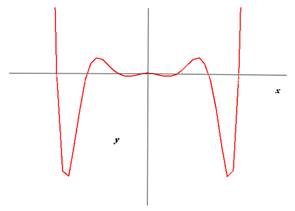
(a)
To find: whether the degree of the polynomial even or odd
(a)
Answer to Problem 120AYU
The degree of this polynomial is even
Explanation of Solution
Given:

Calculation:
Now let us analyze this graph with respect to the problem statement.
This is a characteristic graph of a polynomial function. The degree of this polynomial is even or else the graph will not be that of a polynomial function.
Conclusion:
The degree of this polynomial is even
(b)
To find: whether the leading coefficient positive or negative
(b)
Answer to Problem 120AYU
The leading coefficient is positive,
Explanation of Solution
Calculation:

The leading coefficient is positive, as the graph is upwards.
Conclusion:
The leading coefficient is positive,
(c)
To find: whether the function even, odd, or neither
(c)
Answer to Problem 120AYU
The given function is even
Explanation of Solution
Calculation:
The polynomial function shown in the graph will be even as it is symmetric about y-axis.
Even functions are symmetric about y-axis.
Conclusion:
The given function is even
(d)
To explain: why
(d)
Answer to Problem 120AYU
The polynomial function shown in the graph is even, has no y-intercept.
Explanation of Solution
Calculation:
The polynomial function shown in the graph is even, has no y-intercept.
Therefore,
Hence, it can have
Conclusion:
The polynomial function shown in the graph is even, has no y-intercept.
(e)
To find: What is the minimum degree of the polynomial?
(e)
Explanation of Solution
Calculation:
The minimum degree of the graph should be 8. Though the crossing points are only 6 with one touching point but with respect to other conditions, the only possibility is a polynomial with degree 8.
Conclusion:
(f)
To find: Formulate five different polynomials whose graphs could look like the one shown. Compare yours to those of other students. What similarities do you see? What differences?
(f)
Explanation of Solution
Calculation:
The graph shown can be any graph for some condition such as the degree of the polynomial should be greater than 8 and should be even. Also the leading coefficient should be positive and
Conclusion:
Chapter 4 Solutions
Precalculus
Additional Math Textbook Solutions
A First Course in Probability (10th Edition)
Elementary Statistics: Picturing the World (7th Edition)
Elementary Statistics (13th Edition)
University Calculus: Early Transcendentals (4th Edition)
Algebra and Trigonometry (6th Edition)
- For each graph in Figure 16, determine whether f (1) is larger or smaller than the slope of the secant line between x = 1 and x = 1 + h for h > 0. Explain your reasoningarrow_forwardPoints z1 and z2 are shown on the graph.z1 is at (4 real,6 imaginary), z2 is at (-5 real, 2 imaginary)Part A: Identify the points in standard form and find the distance between them.Part B: Give the complex conjugate of z2 and explain how to find it geometrically.Part C: Find z2 − z1 geometrically and explain your steps.arrow_forwardA polar curve is represented by the equation r1 = 7 + 4cos θ.Part A: What type of limaçon is this curve? Justify your answer using the constants in the equation.Part B: Is the curve symmetrical to the polar axis or the line θ = pi/2 Justify your answer algebraically.Part C: What are the two main differences between the graphs of r1 = 7 + 4cos θ and r2 = 4 + 4cos θ?arrow_forward
- A curve, described by x2 + y2 + 8x = 0, has a point A at (−4, 4) on the curve.Part A: What are the polar coordinates of A? Give an exact answer.Part B: What is the polar form of the equation? What type of polar curve is this?Part C: What is the directed distance when Ø = 5pi/6 Give an exact answer.arrow_forwardNew folder 10. Find the area enclosed by the loop of the curve (1- t², t-t³)arrow_forward1. Graph and find the corresponding Cartesian equation for: t X== y = t +1 2 te(-∞, ∞) 42,369 I APR 27 F5 3 MacBook Air stv A Aa T 4 DIIarrow_forward
- Middle School GP... Echo home (1) Addition and su... Google Docs Netflix Netflix New folder 9. Find the area enclosed by x = sin²t, y = cost and the y-axis.arrow_forward2. Graph and find the corresponding Cartesian equation for: (4 cos 0,9 sin 0) θ ε [0, 2π) 42,369 I APR 27 3 MacBook Air 2 tv A Aaarrow_forward30 Page< 3. Find the equation of the tangent line for x = 1+12, y = 1-3 at t = 2 42,369 APR A 27 M . tv NA 1 TAGN 2 Aa 7 MacBook Air #8arrow_forward
 Calculus: Early TranscendentalsCalculusISBN:9781285741550Author:James StewartPublisher:Cengage Learning
Calculus: Early TranscendentalsCalculusISBN:9781285741550Author:James StewartPublisher:Cengage Learning Thomas' Calculus (14th Edition)CalculusISBN:9780134438986Author:Joel R. Hass, Christopher E. Heil, Maurice D. WeirPublisher:PEARSON
Thomas' Calculus (14th Edition)CalculusISBN:9780134438986Author:Joel R. Hass, Christopher E. Heil, Maurice D. WeirPublisher:PEARSON Calculus: Early Transcendentals (3rd Edition)CalculusISBN:9780134763644Author:William L. Briggs, Lyle Cochran, Bernard Gillett, Eric SchulzPublisher:PEARSON
Calculus: Early Transcendentals (3rd Edition)CalculusISBN:9780134763644Author:William L. Briggs, Lyle Cochran, Bernard Gillett, Eric SchulzPublisher:PEARSON Calculus: Early TranscendentalsCalculusISBN:9781319050740Author:Jon Rogawski, Colin Adams, Robert FranzosaPublisher:W. H. Freeman
Calculus: Early TranscendentalsCalculusISBN:9781319050740Author:Jon Rogawski, Colin Adams, Robert FranzosaPublisher:W. H. Freeman
 Calculus: Early Transcendental FunctionsCalculusISBN:9781337552516Author:Ron Larson, Bruce H. EdwardsPublisher:Cengage Learning
Calculus: Early Transcendental FunctionsCalculusISBN:9781337552516Author:Ron Larson, Bruce H. EdwardsPublisher:Cengage Learning





